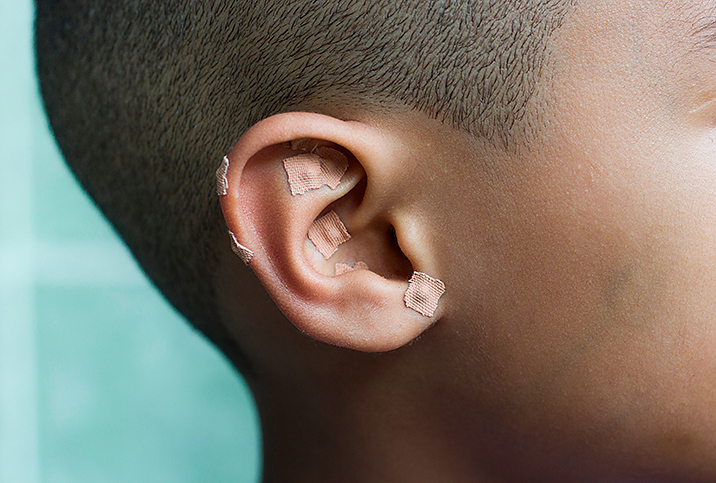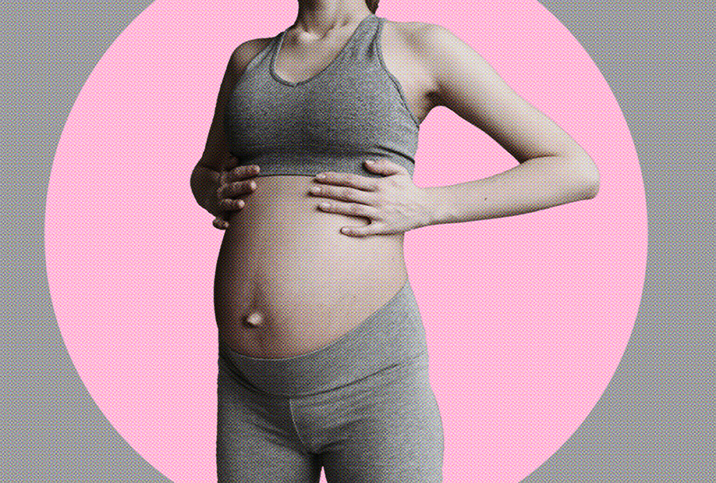WTF Is Ear Seeding—and Can It Help Fibroid Pain?

I'd never heard of ear seeding before my acupuncturist started ending my treatment sessions by placing tiny balls at select points within one ear.
Ear seeding (or auricular acupuncture) is a wear-at-home treatment placed on more than 200 pressure points on the external surface of the ear that correspond to organs, according to traditional Chinese medicine. When stimulated, the seeds are believed to help treat pathologic conditions in the body. My acupuncturist uses ear seeding to continue to treat my uterine fibroid between weekly acupuncture sessions.
There is limited research on the practice, so, as always, talk to your doctor before starting any new treatment.
What exactly is ear seeding?
"Ear seeding, also known as auriculotherapy, is a modality of traditional Chinese medicine (TCM) in which small seeds are placed on acupuncture points on the ear," explained Shannon Lawrence, D.A.O.M. at Seyhart in Santa Monica, California.
Traditional Chinese Medicine is a practice that has evolved over thousands of years, and practitioners of TCM use various physical approaches, such as acupuncture, in combination with herbal supplements to solve health problems.
Acupuncture focuses on stimulating parts of the body to activate areas of the brain that process pain. While there are limited studies on ear seeding in particular, acupuncture has been proven to reduce pain in many situations. A 2018 meta-analysis found acupuncture to be an effective treatment option for chronic pain.
"Auricular acupuncture is a treatment system based on normalizing the body's dysfunction through stimulation of points on the ear," explained Elizabeth Trattner, A.P., founder of Helia House in Miami, Florida. Trattner believes ear seeding can resolve pain and illness.
According to TCM, qi (energy) travels along meridians (invisible pathways) found throughout the body—including the ears. According to TCM, "The ear is a microcosm of the body."
"The vagus nerve runs to the ear, and when acupuncture points are stimulated on the ear, it activates the vagus nerve, stimulating the nervous system as well as the brain," Lawrence said. "This benefits all types of pain, stress, anxiety, focus, memory and digestion, and promotes relaxation."
Mapping the ear
According to TCM, the bodily systems (cardiovascular, digestive, reproductive, respiratory, nervous, etc.) can be accessed via the ear. The seeds are placed at "energy points" to stimulate the nervous system to ease stress, insomnia, improve digestion, reduce pain and balance hormones.
"The ear in TCM is representative of the entire body," Trattner said. "There are hundreds of points that correspond to organs, areas of the body, and special points that have a reset effect, like hunger, thirst, calming the mind down, and sympathetic/parasympathetic points."
Trattner broke down the various energy points in the ear according to TCM:
- Shen men, known as the Spirit Gate or Divine Gate, is a balancing and tranquilizing point.
- The antihelix point is for the spine.
- The superior concha is for the kidneys, pancreas, intestines and liver.
- The inferior concha is for the lungs, heart, throat and brain stem.
- The lobe is for the eyes, face, cheek and limbic system.
Traditional Chinese medicine teaches that ear seeding and acupuncture can help the same issues by working on the same energy points in tandem. Ear seeding doesn't puncture the skin like acuneedles do. Instead, the seeds stimulate points over the dermal layer, making it a less invasive option.
Acupuncturists place tiny magnetic or adhesive stones, Vaccaria seeds or metal balls on different acupressure points in the ear that correlate with specific parts of the body. Unlike acupuncture needles, which usually stay in the body for a short time, ear seeds can be worn for several days, which may extend the beneficial effects.
My experience with ear seeding
My practitioner uses ear seeds to follow up on acupuncture treatments and to engage my nervous system between appointments.
The first week I wore metal ear seeds placed with adhesive, a particular point in my inner ear ached severely. When I told my acupuncturist in the following session that one spot had been painful, he placed his fingertip in the exact location and asked if that's where the pain had been.
He knew exactly where I was hurting, as it was the acupressure point that's associated with the uterus. He explained the middle of the front edge of the depression of the triangular fossa corresponds with the uterus. Placing ear seeds at that point in the triangular fossa aims to help with issues surrounding fertility, arousal and irregular menstruation.
Who is ear seeding for?
You don't need to have health issues related to your reproductive system to possibly benefit from ear seeding. Unlike acupuncture, there are no needles involved in placing the ear seeds. It doesn't hurt at all when the seeds are placed. My acupuncturist advised that if a particular seed causes aches during the treatment period, it may be a sign of a health ailment in the body.
While it's always best to have a trusted acupuncturist place ear seeds, there are at-home ear seeding kits if you'd like to try them out yourself after having an acupuncturist show you how to use them. There's an ear seeding kit specifically designed for fertility. You can even get gold ear seeds that look like dainty earrings with magnetic 24K gold-plated ion ear seeds. Most at-home ear seeding kits come with an ear point chart to help you place the seeds correctly.
Lawrence doesn't recommend ear seeding for people in early-stage pregnancy or those who have a history of miscarriage, fainting or seizures.


















